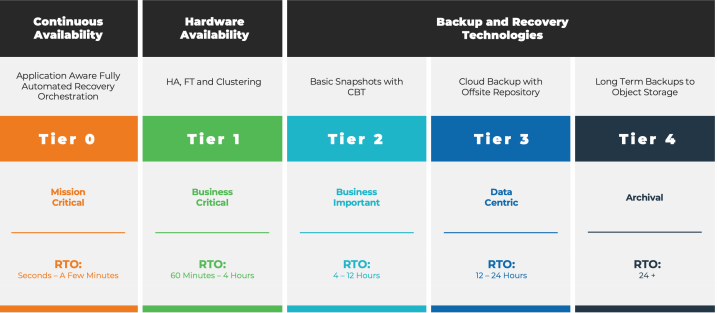Neverfail Solution
Do you think simply using backups to restore your mission critical applications can be done in seconds? We all know the answer to that! So why do we keep forcing a square peg into a round hole?
BACKUP IS FOR DATA RECOVERY, NOT FAILOVER.
Most organizations still rely entirely on backups for business continuity and disaster recovery.
- Why is this the wrong strategy?
- How do you ensure achieving recovery in seconds?
- How can you enable a “hands off”, automated recovery process?
- Why is this so important during a pandemic?
Considerations to Ensuring Recovery For Mission Critical Applications:
1) Time: Mission critical applications are essential to the operation of the business, while also having an imperative impact on revenue. Today’s applications are extremely complex and require specific administrator skills and expertise to get them back and operational as a direct result of a failure.
2) Financial Impact: As mentioned, organizations can be crippled by the financial implications from impacted applications.These applications could be processing critical data for:
• Billing
• Payment systems
• B2B supply chain management
• Donations for NGOs
3) Brand and Reputation Impact: Potentially the worst outcome resulting from a critical system failure is the impact on brand reputation. Any downtime can impact partners and customers who EXPECT your critical systems to always be available. The costs of a critical data loss and long recovery times are incurred in many ways, including:
• Revenue losses
• Customer defection
• Regulatory penalties
• Legal fees
• Cyber extortion
• Outside consultancy for remediation
4) CyberSecurity Compliance: Many Cybersecurity frameworks like NIST, ISO, CMMC, SOC require disaster recovery plans and specific controls to ensure critical systems can be recovered. Most include security control requirements to prove who has access to all aspects of the recovery process. Without automation, cyber-security compliance can be an exhaustive unending challenge.
5) Pandemics: We always focus on the obvious natural disasters like wind, fire, water, and earthquakes. Today, Covid-19 has organizations contending with an added global pandemic that is literally taking out I.T. teams and rending themselves severely at risk for the inability to recover from natural disaster system failures.
Now, we have come to terms with the fact that natural disasters and pandemics can occur simultaneously. Losing staff to sickness was once a rarely considered factor, that is now a front and center risk component.
Neverfail Continuity Engine provides Continuous Availability ensuring that mission critical applications can be recovered with near zero downtime. This technology is powered by true application awareness that can see inside your Windows application server and determine:
The rules-driven automation framework fills the gaps that backup technologies can’t, by providing a “hands off” approach to automatic failover and restoring mission critical applications in seconds, especially in the face of a global pandemic.
Neverfail Continuity Engine provides the highest level of protection available. From the diagram, most backup technologies are best suited for applications that require higher than 4-hour recovery times. Having too many Tier 2 – 4 applications in the midst of a major disaster, exposes the risk of a failed and/or corrupted recovery event.


